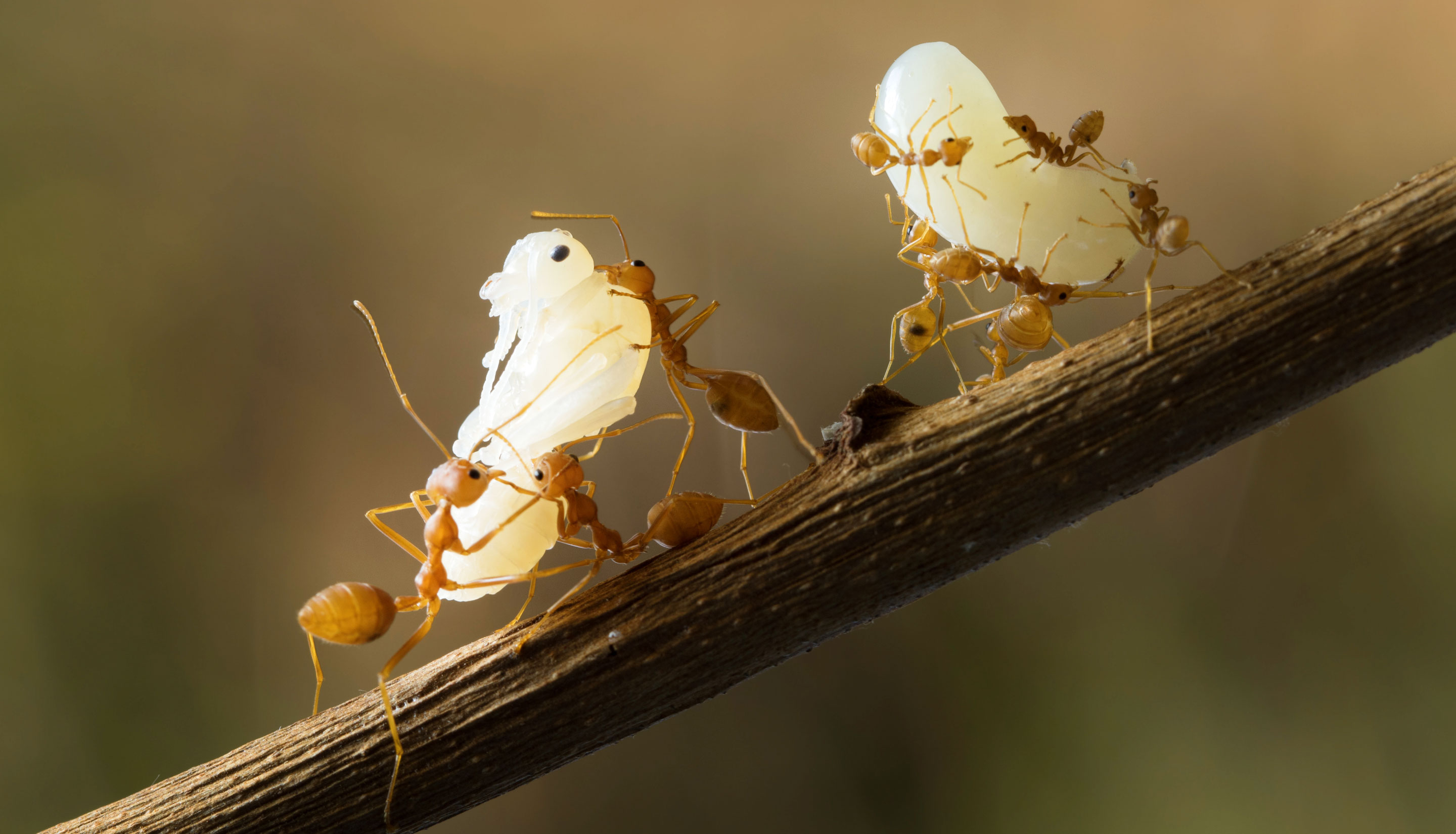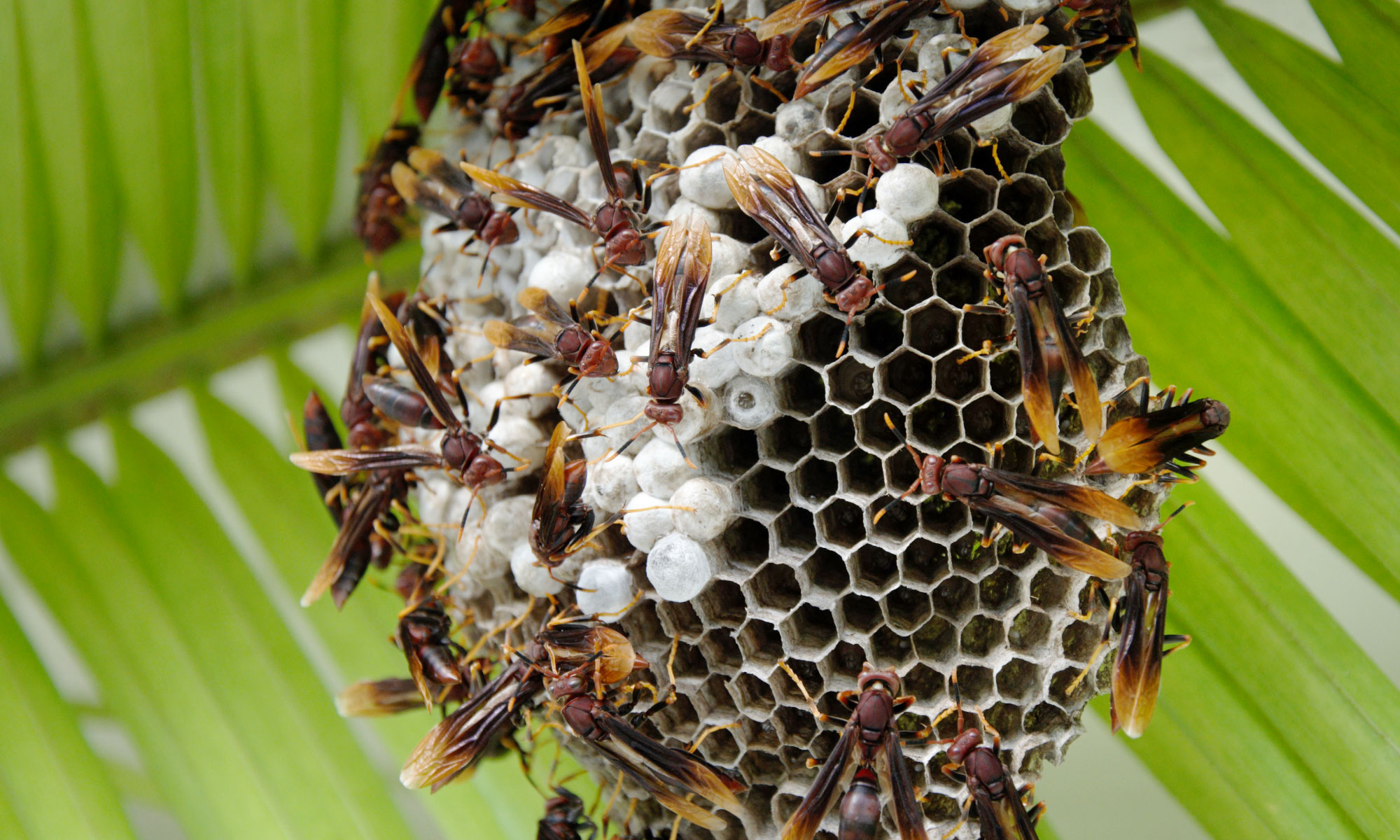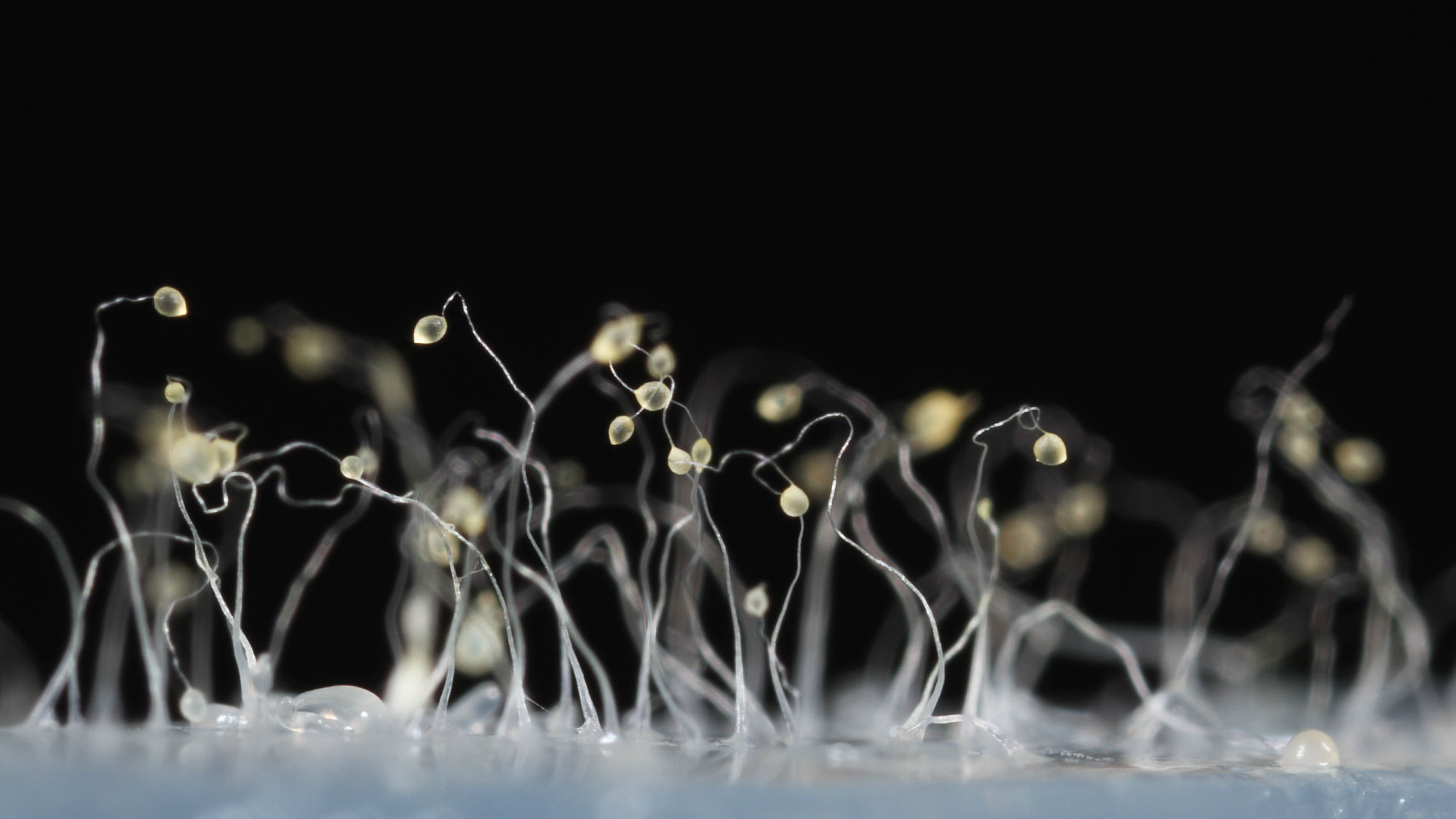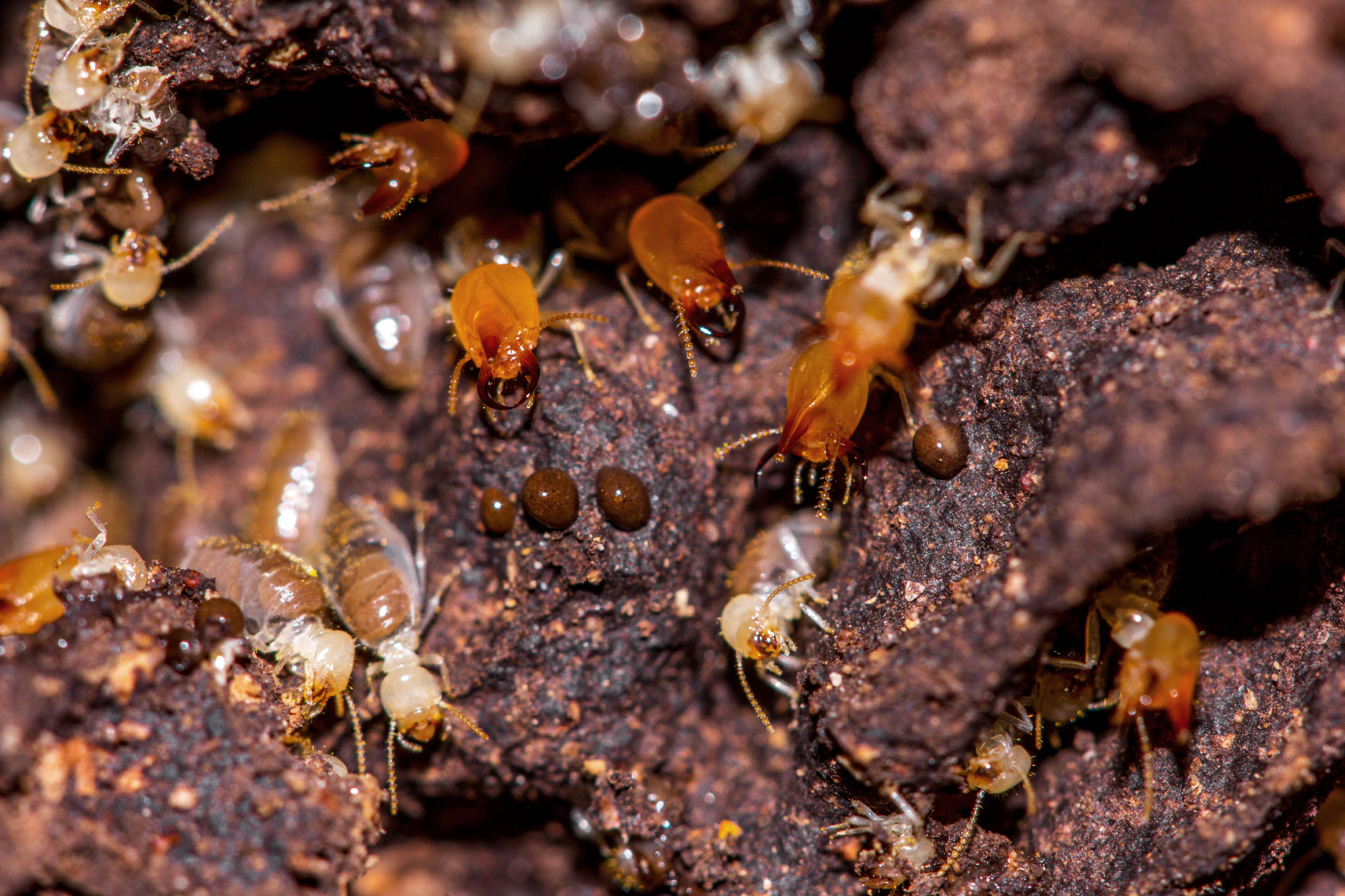The Elusive Calculus of Insects’ Altruism and Kin Selection

These ants are working together to transport their colony’s pupae from their original nest to a new location. (Immature ants can sometimes be bigger than the workers they will eventually become.) Such cooperative acts, even at the price of the workers’ individual fertility, are a hallmark of ant behavior.
Introduction
In 1964, the evolutionary biologist William D. Hamilton seemingly explained one of the greatest paradoxes in biology with a simple mathematical equation. Even Charles Darwin had called the problem his “one special difficulty” a century earlier in On the Origin of Species, writing that it made him doubt his own theory.
The paradox in question is the altruistic behavior exhibited most famously by social insects. Ants, termites, and some bees and wasps live in highly organized colonies in which most individuals are sterile or forgo reproduction, instead serving the select few who do lay eggs. Yet such behavior seemed to clearly violate the concept of natural selection and survival of the fittest, if “fittest” means the individual with the greatest reproductive success. The insects’ compulsory altruism — a form of extreme social behavior called eusociality — made little sense.
But that changed when Hamilton came up with his equation and formalized the theory known as kin selection: the idea that producing fewer offspring of one’s own might be worth it if cooperation increases the offspring of relatives, who share some of one’s genes. (The biochemist J.B.S. Haldane, who pioneered this theory in the 1930s, is often credited with quipping, “I would gladly lay down my life for two brothers or eight cousins.”) Hamilton’s elegant formulation of that insight balanced the costs (c) that one individual incurs by helping another against the benefits (b) that the other receives, weighted by the relatedness of the two (r). Known as Hamilton’s rule, it states that when rb > c, a gene responsible for promoting a social behavior will spread. The rule became the cornerstone of “inclusive fitness theory,” in which fitness can be calculated as a metric of genetic success based on measures of relatedness.
Little did Hamilton know that his rule would also become the center of a volatile debate among theorists studying social behavior.
When Hamilton presented his rule, he demonstrated its cogency by showing that it predicted the behavior of the ants, bees and wasps of the Hymenoptera order, which were primed for eusociality by their strange genetics. The Hymenoptera have an unusual “haplodiploid” system for determining the sex of individuals: Unfertilized eggs become males, and fertilized eggs become females. One consequence of this arrangement is that full sisters on average share all their father’s genes and half of their mother’s. The r value between sisters is therefore ¾, while the r value of offspring to their mother is only ½. Hamilton pointed out that it made evolutionary sense, then, for a worker ant to pass on her genes by helping her mother produce more sisters, rather than by reproducing herself.
The Hymenoptera stood for years as the textbook example of kin selection’s potency, and many biologists got on board with it.

Wasps nesting on a palm frond in Panama raise the colony’s offspring collectively.
Courtesy of Patrick Kennedy
But there were problems. Even though the haplodiploidy hypothesis is still associated with the study of evolved social behaviors, it has been out of favor with experts since 1976, when Robert Trivers and Hope Hare showed how males factor into relatedness. While haplodiploid females are more closely related to their sisters than to their offspring, they still share more genes with their offspring than with their brothers (r is ¼). The evolutionary burden of raising low-value brothers would therefore offset the advantages of rearing high-value sisters.
The theory had an even worse problem when it came to termites and other social species outside the Hymenoptera — because they aren’t haplodiploid. Haplodiploidy couldn’t be the driving force underlying the evolution of those insects’ eusociality.
The hypothesis’s fall from grace put the first crack in what has become a giant rift in scientists’ thinking about inclusive fitness theory and Hamilton’s rule. Because kin selection is still the dominant theory in the field, many biologists continue to base their work on its ideas. Others, however, argue for methods that are not informed by that conceptual framework at all. The debate between the two sides has often been vitriolic, with each one calling the other “cultlike” for its unwillingness to budge.
One of the latest contributions to research in this area, published last month in Nature, offers a novel approach that takes into consideration the effects of nature’s fundamental unpredictability on evolutionary strategies. It also addresses some of the issues at the root of the disagreement among evolution theorists — a disagreement that’s morphed greatly since Hamilton first proposed his formula.
Knowing When the Rules Apply
Hamilton’s rule was never meant to apply to eusocial insect colonies alone. It should describe all social organisms that act cooperatively, such as the ground squirrels that sound off to warn their peers of a nearby predator (at the risk of drawing the predator to themselves) and the scrub jays that devote themselves to raising the offspring of others. There are even some species, such as certain bees, that are “facultatively social,” meaning they only sometimes engage in social behavior, often in response to specific ecological or environmental conditions, and otherwise stay solitary.
How well Hamilton’s rule can account for all these different forms of altruism has been the subject of a debate that can be traced back to the 1960s, when the fight revolved around levels of selection. Hamilton’s rule favors cooperation through the relatedness of individual kin. In contrast, another theory called multilevel selection (or group selection) expands that approach to apply to interactions within and between entire groups of organisms. Many biologists don’t think selection between groups can be strong enough in nature to promote adaptations. The orthodoxy in evolutionary biology is that selection acts mostly within groups, with between-group selection reserved only for very special cases.
In recent years, however, several groups of researchers have demonstrated that kin selection and multilevel selection can be mathematically equivalent: The two concepts merely represent different ways of breaking down the correlation between heritable traits and fitness into “bite-sized components,” said Andrew Gardner, a biologist at the University of St. Andrews in Scotland. “For kin selection, that’s direct versus indirect benefits. For multilevel selection, it’s within groups versus between groups.”
Those developments might suggest that inclusive fitness theory is on a roll. But all is not well with it as an explanation for altruism, or even for eusociality, according to critics like Martin Nowak, a professor of biology and mathematics at Harvard University. Nowak doesn’t just disagree about whether kin selection and multilevel selection are equivalent; he says that the broad mathematical strokes of using Hamilton’s rule to judge fitness are misleading.
The seeds of the dispute were planted in 2010 with the publication of a controversial paper in Nature. Its authors, Nowak, Corina Tarnita and E.O. Wilson, all at Harvard at the time, argued that inclusive fitness theory could not be applied to actual interactions that occur in the wild. According to the authors, it made too many assumptions, most problematically that the benefits and costs of altruism were additive and could be modeled linearly. Hamilton’s rule couldn’t predict the outcome, for instance, if two or more helpers needed to cooperate to confer benefits on an individual.
More than 100 biologists fiercely defended inclusive fitness theory in response to the paper. The conflict gradually came to focus on Hamilton’s rule: While the Nature paper criticized the inaccuracies of a more specific version, the opposing scientists argued that a more general form of the equation would not have the same problems.
Since then, with only the more general version of Hamilton’s rule under consideration, the battle lines of the debate have shifted further. Although “to some extent, they don’t disagree as much as they think they do,” said Jonathan Birch, a philosopher specializing in social evolution and the biological sciences at the London School of Economics and Political Science. When biologists debate Hamilton’s rule today, it’s largely over what they think Hamilton’s rule can tell them, and when to use which models.
Nowak and others claim that the general version of the formula is a tautology that can’t be tested empirically. To them, Hamilton’s rule is essentially just a statistical truism about the relative evolutionary fitness of different groups that lacks explanatory value. “It’s not a statement about biology or natural selection,” Nowak said. “It’s just about statistics, a relationship in mathematics. Like saying 2 plus 2 is equivalent to 4.”
Benjamin Allen, an assistant professor of mathematics at Emmanuel College in Boston, agreed. “This formulation of the rule can only rationalize observations after the fact,” he said. “It can’t predict. There’s no way to see how one observation can systematically lead to the next.”
He and Nowak instead prefer to use models based on population structure, which are often detailed, causal and case-specific. Rather than putting relatedness front and center, they focus on the costs and benefits of the cooperative acts and ask specific questions about factors such as mutations, inheritance and interactions. In the case of the 2010 Nature paper, for example, Nowak, Tarnita and Wilson argued that natural selection favored the rise of eusociality among social insects because survival strategies that enabled the queen to live longer and lay more eggs were advantageous to small colonies.
But others think the simplifications and generalizations of Hamilton’s rule can still be informative. The framework of inclusive fitness theory provides a good way to envision the role played by kin selection and relatedness. According to Birch, it’s too much to expect that a three-variable equation can be a precise predictor of evolutionary dynamics. Rather, it should be understood as a way to organize scientists’ thinking about the causes of social evolution, enabling them to draw a distinction between direct and indirect fitness and know which follow-up questions to ask.

When conditions are harsh, the social amoebas of the species Dictyostelium discoideum mass together. Some of them then sacrifice their own reproductive futures by forming stalks that can elevate the others while they release spores.
He cites Dictyostelium discoideum, a species of social amoebas, by way of example. When their environment turns inhospitable, the single-celled animals aggregate and reproduce by collectively releasing hardy spores into the air from an elevated stalk. But in the process, 20 percent of the amoebas sacrifice themselves to become that stalk instead of making spores, purely to the advantage of the other 80 percent.
To understand the evolutionary logic of this behavior, Birch said, Hamilton’s rule is essential as a starting point for examining how related the stalk and body cells are. “Hamilton’s rule tells researchers on the ground where to look first,” he said. “Then they can move beyond it and construct a more precise model that includes ecological parameters relevant to the particular case.”
But a new paper may have taken a step toward bridging the gap between the general, relatedness-centered approach and the ecological one, with its focus on costs and benefits.
How Uncertainty Favors Altruism
Researchers have noticed counterintuitive examples of cooperation in nature that don’t seem to fit Hamilton’s rule: helpers coming to the aid of individuals that aren’t close relations, for example, instead of having their own offspring. Sometimes the altruistic behavior comes across as incredibly wasteful and doesn’t even seem to improve the survival of their siblings’ offspring all that much, if at all. In one bee species described as facultatively social (meaning that the individuals can choose whether or not to live in colonies), researchers found that the lifetime reproductive success of solitary nesters was almost double that of social ones.
Many of these altruistic situations seem to occur in unpredictable or hostile environments. So a team of researchers, led by Seirian Sumner, a behavioral ecologist at University College London, and Patrick Kennedy, a graduate student at the University of Bristol, sought to extend Hamilton’s rule to account for these exceptions by interweaving it with a concept known as bet hedging. Bet hedging is a risk management strategy that hadn’t previously been formally linked to mathematical models of helping behavior.
Sumner and Kennedy’s key insight was that when scientists use Hamilton’s rule, they usually base their fitness calculations simply on the mean number of offspring that individuals would produce, as measured in the wild. But that model ignores the fact that random variations in the environment make the actual numbers of offspring volatile. When conditions fluctuate dramatically — if food is scarce one year and abundant the next, or if brood parasites sweep through an entire population or the weather oscillates between extremes — the benefits of cooperation vary, too. A better yardstick for judging fitness might therefore be the variance in the numbers of offspring produced.
In other words, it can be more important for an individual’s reproductive success to be consistent on average, rather than simply higher than that of others. In an uncertain environment, the bet-hedging value of helping others starts to look much more appealing as a strategy: It improves the odds that some shared genes will survive even if an individual’s own lineage dies out. Allocating some energy to helping others, even at the expense of further reproductive success, then works as an insurance policy.
Sumner, Kennedy and their colleagues found that, all by itself, uncertainty in the environment could lower the threshold at which individuals need to begin cooperating. “The genes that win out in the long run might not lead to the most number of offspring on average,” Kennedy said, “but in a reduced variance in that number.”
Sheng-Feng Shen, an associate research fellow at Academia Sinica in Taiwan, believes that Sumner and Kennedy’s results will help future inclusive fitness models resemble models based on population dynamics. “This paper shows perfectly why the debate between the two exists,” he said: Sumner and Kennedy have brought Hamilton’s rule more into line with the biological and ecological considerations that critics of inclusive fitness theory have called for.
Empirical field work will be needed to test which environments most favor cooperative behavior, and to what extent it’s driven by environmental unpredictability. But Shen also says the theory needs to be expanded further. For example, the model as it currently stands assumes that generations do not overlap. That assumption works for microbial communities, biofilms and similar organisms, but it needs to be honed to describe vertebrate cooperation accurately.
The new model could even be applied to research on kin selection in plants. Susan Dudley, an evolutionary ecologist at McMaster University in Canada, pointed to the Great Lakes sea rocket, a plant that produces seeds with different dispersal mechanisms: Some of its offspring end up alone, but others settle into groups that may consist of relatives or unrelated plants. “It would be a nice system [in which] to think about bet hedging and kin selection together,” she said.
And while this extension of Hamilton’s rule focuses on what might drive organisms toward social behavior, it might also provide further insights into how the much more stringent eusocial behavior of bees, ants and other insects emerged.
The Importance of Monogamy
Although the haplodiploidy hypothesis was debunked, researchers have continued to draw on relatedness and Hamilton’s rule as explanations for eusociality among the social insects. Today, the dominant theory, formulated by Jacobus Boomsma, an evolutionary biologist at the University of Copenhagen, holds that it was strict lifetime female monogamy that actually caused eusociality to occur. In ants, bees and wasps, for instance, the colony’s queen mates with just one male: She is able to store sperm from one “wedding flight” for use throughout her reproductive life. Termites, which can’t store sperm, keep a king alongside their colony’s queen instead.

Termites evolved eusociality 50 million years before ants, bees and wasps did. Recent research shows that their social behaviors may have developed along similar pathways despite major differences between their biology and that of other social insects.
Because all the members of a colony or hive have the same parents, individuals on average share as many genes with their siblings as they would with any offspring of their own: In Hamiltonian terms, r has a mean value of ½ in both cases (for haplodiploid organisms, this remains true, since the r values of ¾ and ¼ for sisters and brothers, respectively, average out to ½). Consequently, even the slightest benefit from acting altruistically is enough to tilt the scales toward social evolution and castes that rear siblings instead of offspring. “Only strict lifetime commitment between parents is predicted to have ever bred unconditional commitment to reproductive altruism,” Boomsma wrote in an email.
So far, this monogamy theory has been supported by research into the evolutionary histories of eusocial organisms: The ancestors of modern eusocial ants, wasps and bees — as well as the predecessors of eusocial snapping shrimp that dwell in coral reefs off the shores of Belize — were monogamous.
But even so, “there are a lot of subtleties within how those dominance hierarchies form and how those societies maintain stability,” said Sandra Rehan, a biologist at the University of New Hampshire. “It’s much more nuanced than just saying ‘something is social,’ or ‘something is eusocial.’”
Perhaps relatedness alone isn’t always enough to explain eusociality. The monogamy hypothesis predicts the conditions needed to turn simple cooperative behavior into eusociality and hierarchies of individuals that never mate. But what makes certain species ripe for that irreversible transition? This is where Kennedy’s work might help advance understanding. Kennedy thinks it would be enlightening to examine how ecological volatility might affect the costs and benefits involved in the evolution of eusociality. It could be that random changes in the environment push primitive eusociality; he thinks it might be possible to find out by examining those facultatively social species that still have a choice about whether to cooperate. “Not all monogamous [ants, bees and wasps] have evolved eusociality,” Gardner said. “These kinds of volatility considerations could in principle explain why.”
The Chemistry of Social Cohesion
Hamilton’s rule still plays a strong and expanding role in guiding research on social and eusocial populations, even if it does have its limitations. But it can’t stand alone. Just as Shen discussed integrating aspects of population dynamics into the framework of inclusive fitness, other directions of research add to the story.
Such work does not probe just the origin of eusociality; it also explores the genomic events that cemented eusociality’s details after its foundation was laid. A paper in Nature Ecology & Evolution in February, for example, analyzed the genomes of termites and cockroaches, the termites’ non-eusocial ancestor. It found that when cockroaches evolved, the number of genes they carried for a specific class of proteins called gustatory receptors hugely expanded. Then, when the termites evolved, they gave these receptors new jobs. Previously just a tool for perceiving chemical cues in the environment, the receptors gained more specific functions for sensing signals associated with termite activities, such as feeding, laying eggs or aggressive behavior.
Ants, bees and wasps evolved eusociality 50 million years after the termites, but previous research shows that they did something very similar with a different class of proteins called odorant receptors. “Social evolution has evolved independently twice in the insects, and it went down a very similar path,” said Erich Bornberg-Bauer, a molecular biologist at the University of Münster in Germany and one of the study’s authors. That similarity shows how much social behavior depends on chemical recognition, at least in insects.
At the moment, this kind of work on the nuts and bolts of what enables social behavior remains separate from the research by Kennedy and others unpacking the evolutionary pressures that triggered it. For instance, it remains unclear whether the termites’ chemosensory ability evolved because it was useful specifically for helping relatives. “That’s not something we can determine from simple genomic comparisons,” said Xavier Bellés, a biologist at the Institute of Evolutionary Biology in Barcelona and another author of the paper. He noted that the cockroach genome they analyzed could produce twice as many proteins as the genomes of the termites they sequenced, even though termites are socially far more complex.
An enormous obstacle to scientists’ understanding of social evolution revolves around how to unite those insights. By connecting larger evolutionary forces to the smaller forces that shape changes in the genome — a goal still a long way off — researchers might finally solve the mystery of eusociality. For now, honing a more unified mathematical description seems like a good first step.
This article was reprinted on ScientificAmerican.com.



